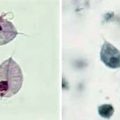Chapter 475 Liver Disease
Because all of the clotting factors except factor VIII are produced exclusively in the liver, coagulation abnormalities are very common in patients with severe liver disease. Only 15% of such patients have significant clinical bleeding states. The severity of the coagulation abnormality appears to be directly proportional to the extent of hepatocellular damage. The most common mechanism causing the defect is decreased synthesis of coagulation factors. Patients with severe liver disease characteristically have normal to increased (not reduced) levels of factor VIII activity in plasma. In some instances, disseminated intravascular coagulation (Chapter 477) or hyperfibrinolysis may complicate liver disease, making laboratory differentiation of severe liver disease from disseminated intravascular coagulation difficult.
Atkison PR, Jardine L, Williams S, et al. Use of recombinant factor VIIa in pediatric patients with liver failure and severe coagulopathy. Transplant Proc. 2005;37:1091-1093.
Kaul V, Munoz SJ. Coagulopathy of liver disease. Curr Treat Options Gastroenterol. 2000;3:433-438.
Monagle P, Andrew M. Acquired disorders of hemostasis. In: Nathan DG, Orkin SH, Ginsburg D, et al, editors. Hematology of infancy and childhood. ed 6. Philadelphia: WB Saunders; 2003:1631-1668.
Pipe SW, Goldenberg NA. Acquired hemostatic defects. In: Orkin SH, Nathan DG, Ginsberg D, et al, editors. Nathan and Oski’s hematology of infancy and childhood. ed 7. Philadelphia: Saunders Elsevier; 2009:1591-1622.







